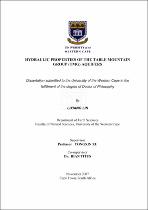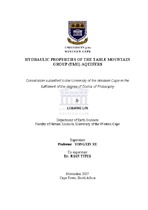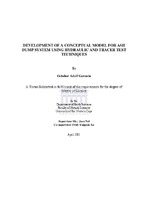| dc.description.abstract | The Table Mountain Group (TMG), located at the southmost cape of African Continent, is one out of three major regional aquifer systems in South Africa, which has a potential of bulk water supply to meet the requirements of irrigation and local municipalities in the Western
and Eastern Cape provinces. The TMG aquifers comprising a thick sequence of hard sedimentary rocks dominated by fractured sandstones have the outcrop area of 37000 km2, the deposit area of 248000 km2 and the thickness ranging from 900m to 4000m. Large-scale
distribution of the TMG over various geological structures leads to a big diversity in its hydrogeological properties, especially the hydraulic properties which are critical in determining the aquifers’ abstraction potential and sustainable yield. A proper estimation of hydraulic properties, with focus on the investigation of aquifer porosity, permeability and storativity, is important for the sound evaluation and sustainable utilization of the groundwater resource in the TMG area. Data from previous studies and current research have been collated and analyzed to help establish conceptual models of the TMG aquifers and to quantify the intrinsic aquifer properties − hydraulic properties. Based on the study of hydrogeological settings and aquifer types, combined with the interpretation of aquifer hydraulic tests, it is realized that the hydraulic properties of the TMG rocks are strongly controlled by fractures regarding the groundwater flow path within the TMG rocks. Media study on the nature of the fractures or fracture networks therefore is conducted in detail. Subsequently, the establishment of the fractured-media conceptual models on the basis of stochastic analyses is helpful for the better understanding of groundwater behaviors in the TMG aquifers. With the data derived from field measurements and interpretation of remote sensing data, the fractured rock hydraulic conductivities are estimated by using a hydraulic conductivity tensor approach. Considering the influential factors such aperture, roughness, stress condition, and most importantly the connectivity of fractures, the tensor model is accordingly modified to meet different boundary
conditions for the estimation of the hydraulic conductivities on the surface and at depth. As a result, the estimated hydraulic conductivities at most sites fall in the range of 10-2~10-3 m/d that is roughly consistent with site pumping test results. However, it decreases with depth
following a negative power law, which implies that the majority of fractures tend to be closed at depth. Site hydraulic tests also show the similar tendency of vertically spatial variation of the hydraulic conductivities. The study of fracture connectivity shows another hydrogeological significance. Fracture networks on the measurement scale present the feature of various fracture blocks in the system rather than they are well connected. The 3-D model demonstrates that very few fractures in the TMG sandstones are competent for groundwater flow. With this regard the computation of hydraulic conductivities is hence calibrated Multiple approaches are employed to estimate porosity and associated aquifer storativity. Results show that porosity of the TMG sandstones is strongly scale-dependent, of which the value of core sample laboratory tests yield a upper limit of 1.0%~3.6%. The porosity of pumping tests and in-situ fracture measurements fall in the middle rang of 0.05%~0.6%, whilst the application of lineament interpretation from remote sensing data produce its lower
limit of 1.2×10-8. Assuming the TMG rocks are homogeneous media, the storativity value should have the same trend at various scales. These results indicate that the TMG groundwater resource at a larger scale may be overestimated if use the aquifer parameters derived from a smaller-scale study. Research findings in current study provide a new insight into the fractured rock aquifers in the TMG area. Some of the results will have wide implications on the groundwater management and forms a solid basis the further study of the TMG aquifers. | en_US |




